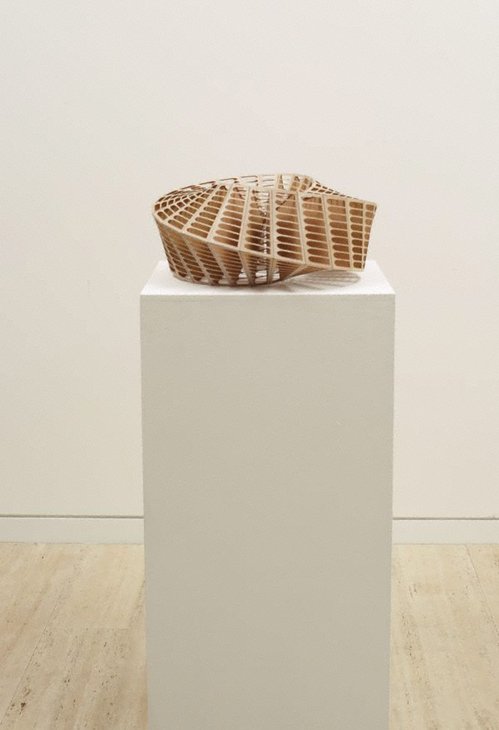-
Details
- Date
- 2006
- Media category
- Sculpture
- Materials used
- steel, aluminium, fiberglass, rubber, leather, automotive lacquer
- Dimensions
- 193.0 x 115.0 x 366.0 cm
- Credit
- Purchased with funds provided by Andrew Cameron, the Contemporary Collection Benefactors and the Rudy Komon Memorial Fund 2006
- Location
- Entrance Pavilion
- Accession number
- 363.2006
- Copyright
- © James Angus, Courtesy Roslyn Oxley9 Gallery
- Artist information
-
James Angus
Works in the collection
- Share
-
-
About
James Angus’s sculptures usually find their subject in things that already exist in the world. His works can be divided into two main spheres, natural creatures and man-made, often architectural structures or manufactured forms. Living things are realised in versions that emphasise their sculptural nature, and inanimate objects are shifted through a series of propositions about physics, gravity and geometry. In ‘Manta Ray’ 2002, the horizontal mass and undulating curves of the creature are eerily still and perfectly hydrodynamic. In ‘Seagram Building’ 2000, a slightly arching version of the modernist icon lies displaced on the floor. Its curving profile is a subtle distortion that is mathematically correct, but physically improbable and visually disorienting. For ‘Bugatti Type 35’ Angus has taken one of the most iconic racing cars of the 20th century, replicated it, but also distorted it through a gravitational shift 30 degrees to the right.
While Angus’s art is not minimal, it shares minimalism’s interest in primary structures and physical presence, and suggests that their source may be found in much earlier developments in modernist architecture and design such as the use of serial repeated forms, manufactured units, structuring grids and highly finished surfaces. The physical and perceptual disorientation of the sculptures, achieved through a mathematically correct displacement of rational geometry, bends our experience of these familiar iconic objects. This immaculate car from the 1920s designed for speed, an ultimate symbol of the modern age and mechanical progress, can no longer support itself upright and tips over, strangely drawn out, its circular wheels becoming ellipses. It seems the real manifestation of the famous early 20th century image by French photographer Jacques Henri Lartigue of a car speeding past, the limitations of photography’s technology seemingly making its wheels stretch.
Bugatti’s car was exceptional because of the visionary solutions he devised for engineering problems. In part the originality of Bugatti’s vision can be attributed to his art school training and artistic talent before he entered into car design. Angus retrieves this immaculately engineered machine and returns it to being art, through both replication and intervention. Angus proposes alternate perceptual models that are inherent in geometry’s rigorous spatial logic and mathematical precision, suggesting other ways, at least in sculptural form, in which we may view the world.
-
Audio
Bugatti Type 35 - James Angus 2:58
-
Exhibition history
Shown in 2 exhibitions
James Angus, Museum of Contemporary Art, Australia, 13 Sep 2006–26 Nov 2006
James Angus, Institute of Modern Art, Fortitude Valley, 02 Jun 2007–28 Jul 2007
James Angus, Bendigo Art Gallery, Victoria, 22 Sep 2007–06 Nov 2007
James Angus, Art Gallery of Western Australia, Perth, 24 Nov 2007–02 Mar 2008
2008 Biennale of Sydney: revolutions-forms that turn, Art Gallery of New South Wales, Sydney, 18 Jun 2008–07 Sep 2008
-
Bibliography
Referenced in 7 publications
-
Richard Jinman, The Sydney Morning Herald, 'It's a shift to the right for this old racer', pg.13, Sydney, 13 Sep 2006, 13 (illus.).
-
Rachel Kent, James Angus, 2006, (colour illus.).
-
Stuart Koop, Beep ... crackle: contemporary art from the middle of nowhere, 'James Angus', pg. 6-15, Fortitude Valley, 2008, 7, 14 (colour illus., detail), 15 (colour illus.).
-
Lisa-Marie Murphy, Foundation Newsletter #24, 'Profile', pg. 3-4, Sydney, Jul 2014, 4 (colour illus.). interview with Andrew Cameron
-
Sebastian Smee, The Australian, 'Watch out for the sharp bends', 25 Sep 2006.
-
Wayne Tunnicliffe and Deborah Edwards, Look, 'New Australia', pg. 24-27, Sydney, May 2012, 24.
-
Andrew Yip, Look, 'Bugatti Type 35: A mythological beast for a mechanical age', pg. 28-29, Sydney, Apr 2012, 28, 29 (colour illus.).
-




